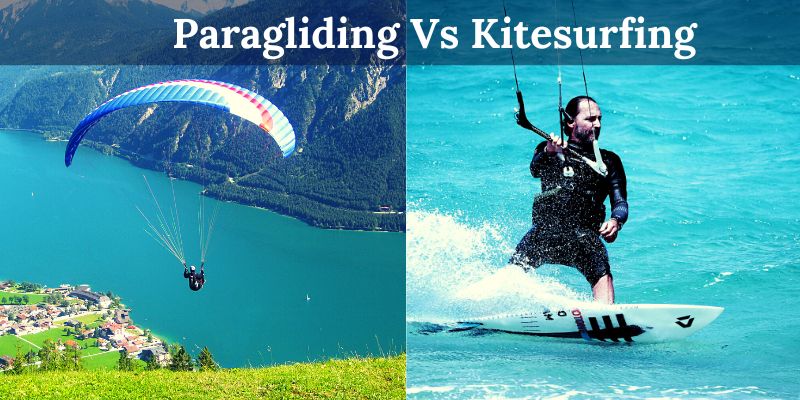Paragliding and kitesurfing are popular airborne sports that offer participants a unique and thrilling experience. However, there are some key similarities and differences between the two activities.
Typically, a kitesurfer will find paragliding easy to practice and vice versa. So when comparing paragliding vs kitesurfing, it is hard to choose because both serve distinct purposes and give different experiences.
Paragliders use just the wind to propel themselves in the air. On the other hand, Kitesurfers use both wind and waves to drive themselves across the water’s surface. In both cases, participants use special equipment to stay airborne. The type of equipment used differs depending on the sport.
Whether you’re looking for an adrenaline-pumping thrill ride or scenic views, either sport will surely provide an unforgettable experience.
Paragliding Vs Kiteboarding
Paragliding is an adventure sport that involves flying a lightweight glider through the air, typically from a cliff. Paragliding can be performed in groups, and pilots can stay in the air for hours. While enjoying the unparalleled views and sense of freedom of flight.
Paragliders usually launch from cliff tops or tall hills. However, they can also be found in winch or car tow thermals. They can also be towed aloft by a powered ‘tug’ aircraft such as a microlight or ultralight.
A professional kitesurfer can perform on various types of terrains. These include open ocean waves, flat water lakes, rushing river sets, and even up to 40 ft waves. Open ocean waves are commonly found downwind of large land masses like Hawaii, Maui, and Baja California.
These waves typically have a long fetch (the distance wind blows across the water surface), which results in high wave energy. These waves’ size, shape, and power make them ideal for kitesurfing. When kiteboarding or kitesurfing on flat water lakes, kitesurfers can ride for miles in any direction.
With so many great places to kiteboard, it’s no wonder this sport has become so popular quickly.
Similarities Between Paragliding and Kitesurfing
When we compare paragliding vs kitesurfing, we observe that both share some basic similarities. These include the tools used and the ideal weather conditions for each sport.
Tools
Both sports share a reasonable number of tools to help the rider gain altitude and maintain control while in flight. Some of these tools include a harness, a bar, a helmet, a bag for carrying these tools, and others.
Weather
Both sports require a steady wind to fly in ideal weather conditions. However, kitesurfing is typically done in stronger winds. The kite needs enough power to keep the rider afloat on the water.
Additionally, both sports can be enjoyed solo or in groups. Both require a certain amount of skill and training to participate safely. Overall, there are many similarities between paragliding and kitesurfing. They are two great options for those looking to enjoy an adrenaline-filled day on the water or in the air.
Frequently Asked Questions on Paragliding Vs Kitesurfing
Should I hang glide or paraglide?
There are many factors to consider when choosing whether to hang glide or paraglide. Both activities offer stunning views and the opportunity to feel like you’re flying. But there are some critical differences between the two.
To control the glider with your body weight, for instance, hang gliding requires more training and experience than paragliding. In addition to being heavier and more extensive than paragliders, turn gliders are more cumbersome to move and set up.
However, paragliders are more easily controlled and may be launched more quickly than hang gliders. Consider turning gliding if you’re willing to do extra work for a more conventional flying experience.
Does your stomach drop while paragliding?
The answer is both yes and no. If you’re properly secured in your harness, you shouldn’t feel discomfort or nausea. However, if your harness isn’t fitted correctly or you’re not used to free-fall sensations, you may start to feel queasy. In general, though, the stomach-dropping sensation is more theoretical than actual.
Which is better, parasailing or paragliding?
There are several key differences between parasailing and paragliding. Parasailing typically involves being towed behind a boat, while paragliding is a form of free flight.
Parasailing is generally considered more gentle and relaxing, while paragliding can be more exhilarating. Additionally, parasailing requires less training and experience than paragliding, making it a more accessible activity for many people.
However, paragliding offers greater freedom, independence, and the ability to cover greater distances. Ultimately, the best way to decide which activity suits you is to try both and see which you enjoy more.
Conclusion
Paragliding vs. kitesurfing, which is the better activity? Paragliding is typically more expensive than kitesurfing and requires more training, but it also offers a more relaxing experience.
On the other hand, kitesurfing is less expensive and doesn’t require as much training, but it’s also more challenging and, therefore, more thrilling.
Ultimately, the decision of which sport to pursue comes down to personal preference. Paragliding is the activity for you if you’re looking for a laid-back way to enjoy stunning views.
Kitesurfing is the way to go if you’re looking for an intense physical challenge. You will surely have a great outdoor experience in whichever sport you choose.

